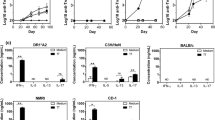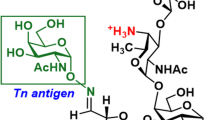Summary
A new haptenic compound, a muramyl dipeptide (MDP) derivative (designated as L4-MDP-ONB) cross-reactive with Bacillus Calmette Guerin (BCG) was synthesized. The cross-reactivity of L4-MDP hapten to BCG was demonstrated from the following evidence; (a) lymph node cells from BCG-primed C3H/HeN mice exhibited appreciable L4-MDP-specific proliferative responses to the in vitro stimulation of L4-MDP-modified syngeneic cells (L4-MDP-self); (b) inoculation of L4-MDP-self into footpads of BCG-primed C3H/HeN mice elicited ample delayed type-hypersensitivity (DTH) responses in vivo as measured by footpad swelling; and (c) BCG-primed mice contained L4-MDP-reactive helper T cell activity which functions to augment the generation of effector T cell responses to cell surface antigens. This crossreactivity between L4-MDP hapten and BCG as measured by the helper T cell activity was applied to enhanced induction of tumor-specific immunity. When BCG-primed C3H/HeN mice were immunized with L4-MDP-modified syngeneic X5563 tumor cells, these mice could generate augmented tumor-specific in vivo protective (tumor neutralizing) immunity as well as in vitro cytotoxic T cell responses. These results indicate the effectiveness of L4-MDP hapten in augmenting tumor-specific immunity. The present approach is discussed in the context of potential advantages of this new hapten for its future application to clinical tumor systems.
Similar content being viewed by others
References
Corradin G, Etlinger HM, Chiller JM (1977) Lymphocyte specificity to protein antigens. I. Characterization of the antigen-induced in vitro T cell-dependent proliferative response with lymph node cells from primed mice. J Immunol 119:1048
Finberg R, Greene MI, Benacerraf B, Burakoff SJ (1979) The cytolytic T lymphocyte response to trinitrophenyl-modified syngeneic cells. I. Evidence for antigen-specific helper T cells. J Immunol 123:1205
Forman J (1975) On the role of the H-2 histocompatibility complex in determining the specificity of cytotoxic effector cells sensitized against syngeneic trinitrophenyl-modified targets. J Exp Med 142:403
Fujiwara H, Shearer GM (1981) Genetic control of cell-mediated lympholysis to trinitrophenyl (TNP)-modified murine syngeneic cells. I. Expression of Ir gene function at the cytotoxic precursor and helper cell levels in the response to TNP-H-2b-self. J Immunol 126:1047
Fujiwara H, Hamaoka T, Shearer GM, Yamamoto H, Terry WD (1980) The augmentation of in vitro and in vivo tumor-specific T cell-mediated immunity by amplifier T lymphocytes. J Immunol 124:863
Fujiwara H, Levy RB, Shearer GM (1981) Analysis of Ir gene control of cytotoxic response to hapten-modified self: Helper T cells specific for a sulfhydryl hapten can substitute for an anti-TNP-H-2b self helper defect. J Immunol 127:940
Fujiwara H, Aoki H, Yoshioka T, Tomita S, Ikegami R, Hamaoka T (1984) Establishment of tumor-specific immunotherapy model utilizing TNP-reactive helper T cell activity and its application to autochthonous tumor system. J Immunol 133:509
Fujiwara H, Moriyama Y, Suda T, Tsuchida T, Shearer GM, Hamaoka T (1984) Enhanced TNP-reactive helper T cell activity and its utilization in the induction of amplified tumor immunity which results in tumor regression. J Immunol 132:1571
Fujiwara H, Shimizu Y, Takai Y, Wakamiya N, Ueda S, Kato S, Hamaoka T (1984) The augmentation of tumor-specific immunity by virus-help. I. Demonstration of vaccinia virus-reactive helper T cell activity involved in enhanced induction of cytotoxic T lymphocyte and antibody responses. Eur J Immunol 14:171
Galili N, Naor D, Asjo B, Klein G (1976) Induction of immune responsiveness in a genetically low-responsive tumor-host combination by chemical modification of the immunogen. Eur J Immunol 6:473
Gilheany PE, Arora PK, Levy RB, Shearer GM (1981) H-2 linked genetic control of murine cell-mediated lympholysis to autologous cells modified with high and low concentration of fluorescein isothiocyanate (FITC). Cell Immunol 59:97
Hamaoka T, Fujiwara H, Teshima K, Aoki H, Yamamoto H, Kitagawa M (1979) Regulatory functions of hapten-reactive helper and suppressor T lymphocytes. III. Amplification of a generation of tumor-specific T-lymphocyte activities by suppressor T-cell-depleted hapten-reactive T lymphocytes. J Exp Med 149:185
Hashimoto Y, Yamanoha B (1976) Induction of transplantation immunity by dansylated tumor cells. Gann 67:315
Igarashi T, Okada M, Azuma I, Yamamura Y (1977) Adjuvant activity of synthetic N-acetylmuramyl-L-alanyl-D-isoglutamine and related compounds on cell-mediated cytotoxicity in syngeneic mice. Cell Immunol 34:270
Iribe H, Koga T (1984) Augmentation of the proliferative response of thymocytes to phytohemagglutinin by the muramyl dipeptide. Cell Immunol 88:9
Kobayashi H, Kodama H, Gotohda E (1977) Xenogenization of tumor cells. Hokkaido University Medical Library Series vol 9 Hokkaido Japan
Lindenmann J, Klein P (1967) Viral oncolysis: increased immunogenicity of host cell antigen associated with influenza virus. J Exp Med 126:93
Lowy I, Bona C, Chedid L (1977) Target cells for the activity of a synthetic adjuvant; Muramyl dipeptide. Cell Immunol 29:195
Martin WJ, Wunderlich JR, Fletcher F, Inman JK (1971) Enhanced immunogenicity of chemically-coated syngeneic tumor cells. Proc Natl Acad Sci USA 68:469
Mitchison NA (1970) Immunologic approach to cancer. Transplant Proc 2:92
Oberling F, Bernard C, Morin A, Chedid L, Lang JM, Choay J (1982) Effect of MDP (Glu) OnBu on the antibody response against tetanus toxoid in cancer patients. Int J Immunopharmacol 4:309
Pohlit H, Haas W, von Boehmer H (1979) Cytotoxic T-cell response to haptenated cells. I. Primary, secondary and long term cultures. Eur J Immunol 9:681
Rehn TG, Shearer GM, Koren HS and Inman JD (1976) Cell mediated lympholysis of N-(3-nitro-4-hydroxy-5-iodophenyl-acetyl)-6-alanyl-glycylglycyl-modified autologous lymphocytes: effector cell specificity to modified cell surface components controlled by the H-2K and H-2D serological regions of the murine major histocompatibility complex. J Exp Med 143:127
Shearer GM, Rehn TG, Garbarino CA (1975) Cell mediated lympholysis of trinitrophenyl-modified autologous lymphocytes. Effector cell specificity to modified cell surface components controlled by the H-2K and H-2D serological region of the murine major histocompatibility complex. J Exp Med 141:1348
Shearer GM, Schmitt-Verhulst A-M, Pettinelli CB, Miller MW, Gilheany PE (1979) H-2 linked genetic control of murine T cell-mediated lympholysis to autologous cells modified with low concentrations of trinitrobenzene sulfonate. J Exp Med 149:1407
Shimizu Y, Fujiwara H, Ueda S, Wakamiya N, Kato S, Hamaoka T (1984) The augmentation of tumor-specific immunity by virus-help. II. Enhanced induction of cytotoxic T lymphocyte and antibody responses to tumor antigens by vacciniareactive helper T cells. Eur J Immunol 14:839
Takai Y, Mizuochi T, Fujiwara H, Hamaoka T (1984) Effects of hapten epitope structure and hapten-self conjugation pattern on T cell specificity and Ir gene control in hapten-self cytotoxic and helper T cell responses. J Immunol 132:57
Takatsu K, Hamaoka T, Tominaga A, Kanamasa Y (1980) Augmented induction of tumor-specific resistance by priming with PPD-coupled syngeneic tumor cells. J Immunol 125:2367
Author information
Authors and Affiliations
Rights and permissions
About this article
Cite this article
Hamaoka, T., Takai, Y., Kosugi, A. et al. The augmentation of tumor-specific immunity using haptenic muramyl dipeptide (MDP) derivatives. Cancer Immunol Immunother 20, 183–188 (1985). https://doi.org/10.1007/BF00205573
Received:
Accepted:
Issue Date:
DOI: https://doi.org/10.1007/BF00205573




